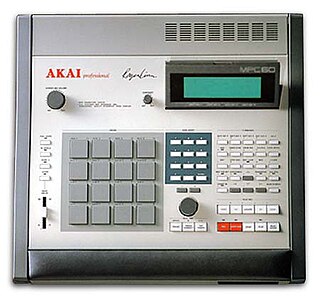 W
WThe Akai MPC is a series of music workstations produced by Akai from 1988 onwards. The MPC combines sampling and sequencing functions.
 W
WAn analog sequencer is a music sequencer constructed from analog (analogue) electronics, invented in the first half of the 20th century.
 W
WB-Step Sequencer is a multitrack software MIDI step sequencer that is available as either a standalone application or in audio plug-in format. Primarily used to create melodical sequences to trigger soft or hardware synthesizer, whether in a studio environment or live on stage, it has a user interface based on pattern and TR music sequencers.
 W
WA drum machine is an electronic musical instrument that creates percussion sounds, drum beats, and patterns. Drum machines may imitate drum kits or other percussion instruments, or produce unique sounds, such as synthesized electronic tones. Most modern drum machines allow users to program their own rhythms and beats. Drum machines may create sounds using analog synthesis or play prerecorded samples. Some drum machines have buttons or pads that allow the performer to play drum sounds "live", either on top of a programmed drum beat or as a standalone performance. Drum machines have a range of capabilities, which go from playing a short beat pattern in a loop, to being able to program or record complex song arrangements with changes of meter and style.
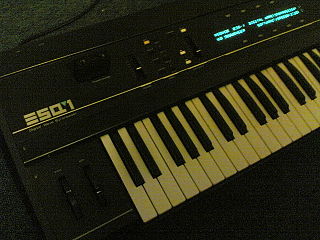 W
WEnsoniq ESQ-1 is a 61-key, velocity sensitive, eight-note polyphonic and multitimbral synthesizer released by Ensoniq in 1985. It was marketed as a "digital wave synthesizer" but was an early Music Workstation. Although its voice generation is typically subtractive in much the same fashion as most analog synthesizers that preceded it, its oscillators are neither voltage nor "digitally controlled", but true digital oscillators, provided by a custom Ensoniq wavetable chip. The signal path includes analog resonant low-pass filters and an analog amplifier.
 W
WFugue Machine is a music sequencer created by San Francisco composer and software developer Alexander Randon, also known by his stage name as Alexandernaut. Marketed as the "world’s first multi-playhead piano roll," Fugue Machine allows the user to sequence a melody and have up to three variations of it play all at the same time. The application was originally released on October 8, 2015 for iOS, and quickly garnered notability for its intuitive methods of making complex pieces and for being the first app to be developed from the "Cultural Incubator" program by the Gray Area Foundation for the Arts.
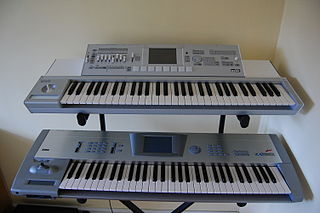 W
WThe Korg Triton is a music workstation synthesizer, featuring digital sampling and sequencing, released in 1999. It uses Korg's HI Synthesis tone generator and was eventually available in several model variants with numerous upgrade options. The Triton became renowned as a benchmark of keyboard technology, and has been widely featured in music videos and live concerts. At the NAMM 2007, Korg announced the Korg M3 as its successor.
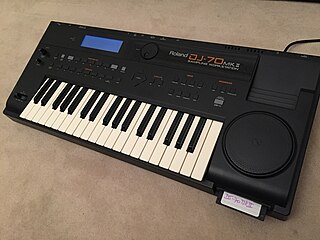 W
WThe Roland DJ-70 is a 16-bit linear A/D Conversion & 20-bit linear D/A Conversion sampling workstation and was released in 1992 by Roland Italy.
 W
WThe Roland MC-4 MicroComposer was an early microprocessor-based music sequencer released by the Roland Corporation. It could be programmed using the ten key numeric keyboard or a synthesizer keyboard using the keyboards control voltage and gate outputs. It was released in 1981 with a list price of US$3,295 and was the successor to the MC-8, which in 1977 was the first microprocessor-based digital sequencer. Like its predecessor, the MC-4 is a polyphonic CV/Gate sequencer.
 W
WThe Roland MC-8 MicroComposer by the Roland Corporation was introduced in early 1977 at a list price of US$4,795. It was one of the earliest stand-alone microprocessor-driven CV/Gate music sequencers, following EMS Sequencer 256 in 1971 and New England Digital's ABLE computer (microprocessor) in 1975. Roland called the MC-8 a "computer music composer" and it was considered revolutionary at the time, introducing features such as a keypad to enter note information and 16 kilobytes of random access memory which allowed a maximum sequence length of 5200 notes, a huge step forward from the 8-16 step sequencers at the time. It also allowed the user to allocate multiple pitch CVs to a single Gate channel, creating polyphonic parts within the overall sequence. Due to the high price, only 200 units were sold worldwide, but it represented a huge leap forward in music technology.
 W
WThe MPU-401, where MPU stands for MIDI Processing Unit, is an important but now obsolete interface for connecting MIDI-equipped electronic music hardware to personal computers. It was designed by Roland Corporation, which also co-authored the MIDI standard.
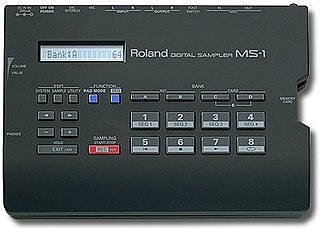 W
WThe Roland MS-1 Digital Sampler was a compact, 16-bit digital audio phrase sampler produced by Roland in 1994 as a straightforward, inexpensive, entry-level sampler. In the year of 1998, the sampler was succeeded by the Boss SP-202 sampler.
 W
WThe Boss Dr. Sample SP-303 is a discontinued digital sampler from Boss, based upon the Roland MS-1 Digital Sampler and Boss SP-202 Dr. Sample. The SP-303 was revamped and redesigned in 2005, and released as the SP-404, by Roland Corporation.
 W
WThe Roland SP-404 Sampling Workstation is a discontinued sampler made by Roland Corporation. Released in 2005, it is part of the SP family and successor to where Boss Corporation’s SP-505 sampler left off. The sampler was succeeded by the SP-555 in 2008, but was later given its own upgrade as the Roland SP-404SX Linear Wave Sampler in 2009. Another upgrade, the Roland SP-404A Linear Wave Sampler was released in 2017.
 W
WA walkstation is an electronic music device which provides musicians with the facilities of a music workstation in a portable package. The term was introduced as part of the marketing for the Yamaha QY10, presumably as a portmanteau of Walkman and workstation. Its usage is typically limited to the portable members of Yamaha's QY sequencer family.